Rod Carew
Rodney Cline Carew (born October 1, 1945)[1] is a Panamanian former Major League Baseball (MLB) first baseman, second baseman and coach who played from 1967 to 1985 for the Minnesota Twins and the California Angels. The greatest contact hitter in Twins history, he won the 1977 AL Most Valuable Player Award, setting a Twins record with a .388 batting average.[2] Carew appeared in 18 straight All-Star Games and led the AL in hits three times, with his 239 hits in 1977 being twelfth most at the time.[3] He won seven AL batting titles, the second most AL batting titles in history behind Ty Cobb, and on July 12, 2016 the AL batting title was renamed to the Rod Carew American League batting title.[4]
| Rod Carew | |||
|---|---|---|---|
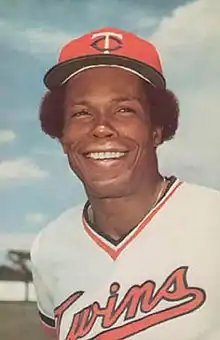 | |||
| First baseman / Second baseman | |||
| Born: October 1, 1945 Gatún, Panama Canal Zone | |||
| |||
| MLB debut | |||
| April 11, 1967, for the Minnesota Twins | |||
| Last MLB appearance | |||
| October 5, 1985, for the California Angels | |||
| MLB statistics | |||
| Batting average | .328 | ||
| Hits | 3,053 | ||
| Home runs | 92 | ||
| Runs batted in | 1,015 | ||
| Teams | |||
| As player
As coach | |||
| Career highlights and awards | |||
| |||
| Member of the National | |||
| Induction | 1991 | ||
| Vote | 90.5% (first ballot) | ||
On August 4, 1985, Carew became the 16th member of the 3,000 hit club with a single to left field off Frank Viola.[5] His 3,053 hits are 27th all time, and his career batting average of .328 is 34th all time. He was elected to the National Baseball Hall of Fame in 1991 in his first year of eligibility;[6] he appeared on upwards of 90 percent of the ballots. He was also elected to the Caribbean Baseball Hall of Fame, Minnesota Twins Hall of Fame, and Angels Hall of Fame. After retiring as a player, Carew served as a coach for the Angels and the Milwaukee Brewers.
Early life
Carew is the son of Olga Teoma, and Eric Carew, Sr. a painter.[6] Carew is a Zonian and was born to a Panamanian mother on a train in the town of Gatún, which, at that time, was in the Panama Canal Zone.[7] The train was racially segregated; white passengers were given the better forward cars, while non-whites, like Carew's mother, were forced to ride in the rearward cars. Traveling on the train was Dr. Rodney Cline, who delivered the baby. In appreciation for this, Mrs. Carew named the boy Rodney Cline Carew.[6][7][8] Carew later acknowledged in 2020 that he and his father Eric had a very tumultuous relationship, even stating "Baseball was the one thing that kept me from killing my father."[9][10] In his memoir One Tough Out, Carew stated that his father was a violent alcoholic who would often physically abuse him and his mother and that he eventually came close to killing him with a machete he obtained.[10]
At age 14, Carew and his siblings immigrated to the United States to join his mother, Olga, in the Washington Heights section of the borough of Manhattan, New York City.[6][11] Although Carew attended George Washington High School, he never played baseball for the high school team. According to Carew, his interest in baseball developed at the age of 20, when his mother convinced him he could get away from his father -who Carew came close to killing after knocking him to the ground and standing over with the machete- if he played baseball.[10] Carew later played semi-pro baseball for the Bronx Cavaliers,[12] which is where he was discovered by Minnesota Twins' scout Monroe Katz (whose son, Steve, played with Carew on the Cavaliers). Katz then recommended Carew to another Twins' scout, Herb Stein, who arranged a tryout in April 1964,[13] and Carew performed so well that manager Sam Mele finished the tryout early so that the Yankees would not see him.[13] Herb Stein along with Katz signed Carew to an amateur free agent contract (at the Stella D'Oro Restaurant in the Bronx) on June 24, 1964[14][15] for a monthly salary of $400 (equivalent to $3,297 in 2019).[6]
Starting his minor league career, Carew was assigned to play second base with the Melbourne (Florida) Twins in the Cocoa Rookie League and hit .325 over the final 37 games of the season.[16] Over the next two years he would end up hitting .302 in Class A[16] playing second base for the Wilson Tobs and the Orlando Twins.[6]
Major league career
Minnesota Twins
In the top of the second inning on April 11, 1967, at Memorial Stadium against the Baltimore Orioles, Carew hit a single for his first major league hit in his first plate appearance,[17] he would finish the game going 2–4.[6] A few weeks later against the Washington Senators, Carew went 5–5 with a double and a stolen base for the first 5–hit game of his career.[18] He was elected to the first of his 18 consecutive All-Star game appearances, and won the American League (AL) Rookie of the Year award[6][8][19] receiving 19 of 20 first place votes.[20] In a game against the Detroit Tigers at Metropolitan Stadium on May 8, 1969, Cesar Tovar led off the bottom of the third with a single.[21] With Carew at bat, pitcher Mickey Lolich balked and Tovar moved to second base, then stole third. Carew walked, then executed a double steal with Tovar as Tovar stole home and Carew stole second. Carew then stole third base, followed by a steal of home. This marked the 41st time in Major League history and the 20th time in AL history that a runner had stolen every base in an inning.[21][22] Carew stole home seven times in 1969, leading the major leagues in this category and just missing Ty Cobb's record of eight. Carew's seven steals of home in 1969 was the most in the majors since Pete Reiser stole seven for the Brooklyn Dodgers in 1946. Manager Billy Martin had worked with Carew throughout the 1969 season to learn how to steal home,[23] and teammate Sandy Valdespino had taught Carew how to bunt more effectively,[23] at the end of the season he led the AL with a .332 batting average, the second-place finisher, Reggie Smith, had a .309 average.[24]

Carew had hit for the cycle on May 20, 1970 against the Kansas City Royals, going 4–5 with a stolen base,[25] this was the first cycle hit by a member of the Twins.[6] Later that year, on June 22, he was injured at second base attempting to convert a double play, he had surgery to repair ligaments in his left leg, and missed 92 games.[6] In 1972, Carew led the AL in batting, hitting .318; he had no home runs for the only time in his career. This was the first time since 1918, when Zack Wheat won the National League batting championship, that a player won the batting title with no home runs.
The start of the 1973 season was slow, Carew was only hitting .246 by the end of April.[26] Carew performed well during the summer months, including a 5–hit performance on August 14.[27] By the end of September he was back in the major league lead with a .353 average.[26] When the season concluded he won his third batting title, with a major league leading .350 batting average.[28] His 203 hits and 11 triples also led the AL.[19][29] The next season, Carew had his best year to date, from his first at bat on April 5, against the Kansas City Royals,[30] he never batted below .300 for the entire year.[31] Through June 27 he was batting .400[31] but cooled off near the end of the season. His 213 hits were a career high, and led the majors,[32] and he collected his fourth career batting title with a .364 batting average.[19]
In 1975, Carew won his fourth consecutive AL batting title.[19] He joined Ty Cobb as the only players to lead the major leagues in batting average for three consecutive seasons. Seeing time predominantly at second base early in his career, Carew moved to first base in September 1975 and stayed there for the rest of his career.[6] Carew missed out on winning another batting title in 1976 as his .331 average was only .002 behind the league leader George Brett. Carew still collected career highs in stolen bases, games played and triples, and had 200 hits for the third time in his career.[19]
In the 1977 season, Carew batted .388, which was the highest since Boston's Ted Williams hit .388 in 1957; he won the 1977 AL Most Valuable Player (MVP) Award. He also set career highs with 239 hits (at that time the most by any player since 1930),[33] 100 RBIs and 128 runs scored. In the summer of 1977, Carew appeared on the cover of Time with the caption "Baseball's Best Hitter".[34] He won his seventh and final batting title in 1978, hitting .333.[19] He had finished in the top 15 in AL MVP voting in every season between 1972 and 1978.[19]
California Angels
In 1979, allegedly frustrated by the Twins' inability to keep young talent, some racist comments by Calvin Griffith, and the Twins' overall penny-pinching negotiating style,[15] Carew announced his intention to leave the Twins. On February 3, Carew was traded to the Angels for outfielder Ken Landreaux, catcher/first baseman Dave Engle, right-handed pitcher Paul Hartzell, and left-handed pitcher Brad Havens.[35] Although it would have represented an infusion of talent, the Twins were unable to complete a possibly better deal with the New York Yankees in January in which Carew would have moved to the Yankees in exchange for Chris Chambliss, Juan Beníquez, Dámaso García, and Dave Righetti.[36] In 2020, Carew denied the longtime allegations that the controversial comments which Griffith made in 1978 suggesting support for Minnesota having a low African-American population and the idea that blacks preferred wrestling to baseball was what triggered his trade to the Angels, stating "When he traded me prior to the 1979 season, Calvin told me he wanted me to be paid what I was worth. Later that year the Angels made me the highest paid player in baseball. A racist wouldn't have done that."[37]
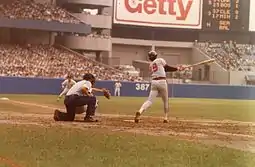
Though Carew did not win a batting title after 1978, he hit between .305 and .339 from 1979 to 1983.[19] In 1982, Carew broke his hand early in the season. Newspaper reports characterized him as swinging one-handed that season due to pain, but he put together a 25-game hitting streak at one point in the season.[38] He played in 138 games that year and hit .319. The Angels went to the playoffs in 1982, which was Carew's fourth and final appearance in postseason play. The team lost a five-game series (three games to two) to the Milwaukee Brewers. Carew played in all five games, but he hit .176 (three hits in 17 at-bats).[19] (Carew grounded out to end the Fifth and final game, hitting a routine groundball to Robin Yount at short, a pitch by Pete Ladd, who was a minor league journeyman replacing the injured Brewer Ace Rollie Fingers).
On August 4, 1985, Carew joined an elite group of ballplayers when he got his 3,000th base hit against Minnesota Twins left-hander Frank Viola at the former Anaheim Stadium.[8] The 1985 season was his last. After the season, Rod Carew was granted free agency, after the Angels declined to offer him a new contract, but he received no offers from other teams. Carew suspected that baseball owners were colluding to keep him (and other players) from signing.[39] On January 10, 1995, nearly a decade after his forced retirement, arbitrator Thomas Roberts ruled that the owners had violated the rules of baseball's second collusion agreement. Carew was awarded damages equivalent to what he would have likely received in 1986: $782,035.71.[39] Carew finished his career with 3,053 hits and a lifetime batting average of .328.[40]
Through 2017, Carew still holds many places on the Twins all-time franchise lists including: the highest career batting average (.334), the second highest on-base percentage (.393; tied with Buddy Myer), fourth highest in intentional walks (99), and fifth in hits (2,085) and stolen bases (271).[41] He also holds many places in Angels franchise history including highest career on-base percentage (.393), the second highest batting average (.314), and sixth highest in both intentional walks (45) and sacrifice hits (60).[42] Carew's career total of 17 steals of home ties him for 17th on the all-time MLB list with former New York Giant MVP Larry Doyle and fellow Hall of Famer Eddie Collins.[8][14]
Career statistics
In 2,469 games over 19 seasons, Carew posted a .328 batting average (3,053-for-9,315) with 1,424 runs, 445 doubles, 112 triples, 92 home runs, 1,015 RBI, 353 stolen bases, 1,018 bases on balls, .393 on-base percentage and .429 slugging percentage. Defensively, he recorded a .985 fielding percentage playing at first and second base. In 14 ALCS games, he hit .220 (11-for-50) with 6 runs, 4 doubles, 1 RBI, 2 stolen bases and 5 walks.[19]
Outside baseball
Military service
During the 1960s, Carew served a six-year commitment in the United States Marine Corps Reserve as a combat engineer.[43] He later said that his military experience helped him in his baseball career. Carew said, "When I joined the Marine Corps, it was a life-changing event for me because I learned about discipline. When I first came up to the big leagues in 1967, I was a little bit of a hot-head. But after two weeks of war games every summer, I realized that baseball was not do-or-die. That kind of discipline made me the player I became."[44]
Confusion over conversion to Judaism
There is no evidence that Carew ever formally converted to Judaism, although he wore a chai necklace during his playing days. His first wife, Marilynn Levy, is Jewish,[35] and he was a member of Temple Beth Shalom in Santa Ana, California. Their three daughters, Charryse, Stephanie, and Michelle,[45] were raised in the Jewish tradition and had their bat mitzvahs there. When one daughter, Michelle, died of leukemia at age 18, services were held at Beth Shalom,[46] and she was buried in the family plot at the United Hebrew Brotherhood Cemetery in Richfield, Minnesota, a suburb of Minneapolis, where Rod Carew played for the Minnesota Twins.[47] Carew, however, still identified as Episcopalian during their relationship.[45]
A 1976 article written in Esquire magazine was one of the first publications to assert that Carew is Jewish. Sportswriter Harry Stein released his "All-Time All-Star Argument Starter" article which consisted of five different ethnic-based baseball teams. Carew was erroneously named the second baseman on Stein's All-Jewish team. A 2007 Salon article named Carew one of the 18 best Jewish ballplayers of all time; the article clarified that Carew was not Jewish but commended him for raising his children in the faith and for marrying Levy in spite of death threats he received.[48]
Another source propagating the story is the 1994 song, "The Chanukah Song", written and performed by entertainer Adam Sandler, in which he lists famous Jews of the 20th century: "...O.J. Simpson... not a Jew! But guess who is: Hall of Famer Rod Carew. - He converted." Carew later wrote Sandler and explained the situation, adding that he thought the song was "pretty funny." Neil Diamond later mentioned the ballplayer in his version of "The Chanukah Song". Rod and Marilynn, who began their relationship in 1968, were married and 1970 and later divorced in 2000.[45]
After retirement
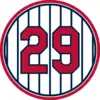 | |
| Rod Carew's number 29 was retired by the Minnesota Twins in 1987. |
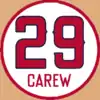 | |
| Rod Carew's number 29 was retired by the California Angels in 1986. |
Carew moved to the community of Anaheim Hills, California while playing with the Angels and remained there after his retirement.[49] Carew was hired as the Angels' hitting coach on November 5, 1991 and served in a similar capacity with the Milwaukee Brewers. He is credited with helping develop young hitters like Garret Anderson, Jim Edmonds, and Tim Salmon. Carew has also worked at various times as a minor league and spring training hitting and base running coach for the Twins and serves as an international youth baseball instructor for Major League Baseball.[50]
Rod married second wife Rhonda in December 2001; she has two children, Cheyenne and Devon. Devout Christians, the family attends Saddleback Church in Lake Forest, California.
On January 19, 2004, Panama City's National Stadium was renamed "Rod Carew Stadium".[51] In 2005, Carew was named the second baseman on the Major League Baseball Latino Legends Team.[52]
Carew's number 29 was retired by the Twins on July 19, 1987, and by the Angels in 1986. Carew was the fourth inductee into the Angels' Hall of Fame on August 6, 1991.[53][54] Carew was elected to the Baseball Hall of Fame in 1991, his first year of eligibility, the 22nd player so elected. In 1999, he ranked #61 on The Sporting News' list of 100 Greatest Baseball Players,[55] and was nominated as a finalist for Major League Baseball's All-Century Team. Carew was inducted into the Hispanic Heritage Baseball Museum Hall of Fame in 2010.[56]
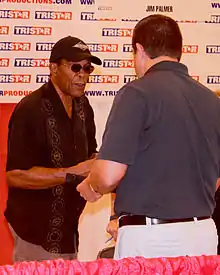
Carew has three biological children from his first marriage – Charryse, Stephanie, and Michelle. In September 1995, his youngest of three daughters, Michelle, was diagnosed with acute myeloid leukemia, a relatively rare leukemia for a young person. Doctors wanted to perform a bone marrow transplant, but Michelle's rare ethnic heritage complicated the search for a matching donor; her father was black with West Indian and Panamanian roots and her mother was of Russian-Jewish ancestry. Carew pleaded for those of similar ethnic background to come forward. When no matching bone marrow donor was found, an umbilical cord blood transplant was performed in March 1996. Michelle died on April 17, 1996 at the age of 18.[57] A statue of her has been installed in Angel Stadium of Anaheim.[58]
Carew began using chewing tobacco in 1964 and was a regular user up to 1992, when a cancerous growth in his mouth was discovered and removed. The years of use had severely damaged his teeth and gums, and Carew has spent a reported $100,000 in restorative dental work.[59]
In September 2015 Carew suffered a massive heart attack while on a California golf course.[60] He was hospitalized for more than six weeks, and had several surgical procedures, which culminated with implantation of a left ventricular assist device (LVAD).[61] Carew recovered sufficiently to take part in the Twins' 2016 spring training as an instructor, coach, and launch the Heart of 29 Campaign.[62] Further, Carew became involved in the branding and launching of a Left Ventricular Assist Device wear company, Carew Medical Wear. In February 2016, Carew indicated that his doctors informed him that he would eventually need a heart transplant.[62] The transplant was done on December 15, 2016.[63] Carew's transplanted heart was donated by former Baltimore Ravens tight end Konrad Reuland. Reuland had attended middle school with Carew's children.[64] Carew participated in the 2018 Rose Parade aboard the Donate Life float on New Year's Day, in honor of Reuland.[65]
In a pre-game ceremony before the 2016 MLB All Star Game in San Diego, the American League batting championship trophy was named the Rod Carew American League Batting Championship Award.[66]
In 2016, Rod Carew was awarded the Bob Feller Act of Valor Award.[67]
See also
- List of Major League Baseball career hits leaders
- List of Major League Baseball career doubles leaders
- List of Major League Baseball career triples leaders
- List of Major League Baseball career runs scored leaders
- List of Major League Baseball career runs batted in leaders
- List of Major League Baseball career stolen bases leaders
- 3,000 hit club
- List of Major League Baseball players to hit for the cycle
- List of Major League Baseball batting champions
- List of Major League Baseball annual runs scored leaders
- List of Major League Baseball annual triples leaders
- DHL Hometown Heroes
- Hispanics in the United States Marine Corps
References
- "Rod Carew Stats, Fantasy & News". MLB.com.
- "Minnesota Twins Top 10 Single-Season Batting Leaders". Baseball-Reference.com. Retrieved February 3, 2020.
- "Single-Season Leaders & Records for Hits". Baseball-Reference.com. Retrieved February 3, 2020.
- Matt Snyder. "MLB All-Star Game: Batting title awards named to honor Tony Gwynn, Rod Carew". CBS Sports. Retrieved February 3, 2020.
- "3,000 Hit Club Exhibit". National Baseball Hall of Fame and Museum. Retrieved February 3, 2020.
- Rod Carew at the SABR Bio Project, by Joseph Wancho, retrieved February 3, 2020
- Goldman, Rob pp. 145
- Pietrusza, David; Matthew Silverman; Gershman, Michael (2000). Baseball: The Biographical Encyclopedia. New York: Total Sports. ISBN 1-892129-34-5.
- https://www.iheart.com/podcast/139-the-dan-barreiro-show-26981004/episode/best-of-bumper-to-bumper-friday-65678440/?cmp=ios_share&sc=ios_social_share&pr=false
- Schad, Chris (June 29, 2020). "Rod Carew: 'Baseball was the one thing that kept me from killing my father'". Bring Me The News. Retrieved October 19, 2020.
- Goldman, Rob pp. 147
- Goldman, Rob pp. 148
- Goldman, Rob pp. 149
- "Stealing Home Base Records by Baseball Almanac". Baseball-almanac.com. Retrieved October 6, 2011.
- "The Last of the Pure Baseball Men". The Atlantic. August 1, 1981. Retrieved October 6, 2011.
- "Rod Carew Minor League Statistics & History". Baseball-Reference.com. October 1, 1945. Retrieved October 6, 2011.
- "Minnesota Twins at Baltimore Orioles Box Score, April 11, 1967". Baseball-Reference.com. Retrieved February 3, 2020.
- "Washington Senators at Minnesota Twins Box Score, May 8, 1967". Baseball-Reference.com. Retrieved February 3, 2020.
- "Rod Carew Statistics". Baseball-Reference.com. Retrieved August 28, 2013.
- "1967 Awards Voting". Baseball-Reference.com. Retrieved February 3, 2020.
- "Major League Baseball Players Who Stole Every Base in an Inning". Baseball-Almanac.com. Retrieved February 4, 2020.
- "Detroit Tigers at Minnesota Twins Box Score, May 18, 1969". Baseball-Reference.com. Retrieved February 4, 2020.
- Goldman, Rob pp. 150
- "1969 AL Batting Leaders". Baseball-Reference.com. Retrieved February 4, 2020.
- "Minnesota Twins at Kansas City Royals Box Score, May 20, 1970". Baseball-Reference.com. Retrieved February 4, 2020.
- "1973 Batting Game Log". Baseball-Reference.com. Retrieved February 4, 2020.
- "Detroit Tigers at Minnesota Twins Box Score, August 14, 1973". Baseball-Reference.com. Retrieved February 4, 2020.
- "1973 MLB Batting Leaders". Baseball-Reference.com. Retrieved February 4, 2020.
- "1973 AL Batting Leaders". Baseball-Reference.com. Retrieved February 4, 2020.
- "Minnesota Twins at Kansas City Royals Box Score, April 5, 1974". Baseball-Reference.com. Retrieved February 4, 2020.
- "1974 Batting Game Log". Baseball-Reference.com. Retrieved February 4, 2020.
- "1974 MLB Batting Leaders". Baseball-Reference.com. Retrieved February 4, 2020.
- "Batting Season & Career Finder: For Single Seasons, From 1871 to 1977, (requiring H>=239), sorted by greatest Hits". Stathead. Retrieved October 16, 2020.
- "Baseball's Best Hitter (Cover)". Time. July 18, 1977. Archived from the original on October 15, 2012. Retrieved February 2, 2014.
- Charlton, James; Shatzkin, Mike; Holtje, Stephen (1990). The Ballplayers: baseball's ultimate biographical reference. New York: Arbor House/William Morrow and Company. pp. 155–156. ISBN 0-87795-984-6.
- "Yankees, Twins still dickering". St. Petersburg Times. United Press International. January 30, 1979. Retrieved June 19, 2009.
- Carew, Rod. "STATEMENT FROM ROD CAREW ON CALVIN GRIFFITH" (PDF). KSTP. Retrieved June 19, 2020.
- "As hand heals, Rod Carew soars". Gainesville Sun. June 25, 1982. Retrieved February 2, 2014.
- Chass, Murray (January 18, 1995). "Baseball; Collusion Case Grants Unusual Damages". The New York Times. Retrieved August 28, 2013.
- "Rod Carew Stats". ESPN.com. Archived from the original on November 14, 2012. Retrieved August 28, 2013.
- "Minnesota Twins Top 10 Career Batting Leaders". Baseball-Reference.com. Retrieved February 3, 2020.
- "Los Angeles Angels of Anaheim Top 10 Batting Leaders". Baseball-Reference.com. Archived from the original on October 22, 2012. Retrieved August 28, 2013.
- Charley Walters. "Tubby Smith's firing leaves undetermined effect on 'Big Three' recruits". St. Paul Pioneer Press. Retrieved February 3, 2020.
- Muder, Craig. "Character and Courage in Cooperstown". Baseball Hall of Fame. Retrieved August 27, 2013.
- Wancho, Joseph. "Rod Carew". Society for American Baseball Research. Retrieved October 19, 2020.
- Reyes, David. "Friends and Family Say Last Goodbye to Michelle Carew". Los Angeles Times. April 20, 1996.
- Reyes, David. "Hundreds of Minnesotans Attend Funeral for Michelle Carew". Los Angeles Times. April 20, 1996.
- Keri, Jonah. "The 18 best Jewish ballplayers of all time". Salon.com. Retrieved August 28, 2013.
- McCurdie, Jim (October 13, 1986). "They Have Carew's Number". Los Angeles. Retrieved April 15, 2008.
- "Minnesota Twins Youth Baseball & Softball Training Camps". Mlb.mlb.com. August 26, 2011. Retrieved October 6, 2011.
- Connor, Joe (January 17, 2006). "Welcome to Panama". ESPN. Retrieved December 3, 2008.
- "Chevrolet Presents the Major League Baseball Latino Legends Team unveiled today". MLB.com. Retrieved August 28, 2013.
- "Retired Numbers: Rod Carew". Minnesota.twins.mlb.com. Retrieved October 6, 2011.
- "Angels Retired numbers". Losangeles.angels.mlb.com. Retrieved October 6, 2011.
- http://www.baseball-almanac.com/legendary/lisn100.shtml
- Price, DeAntae (July 13, 2010). "Roberto Clemente, Rod Carew honored at All-Star FanFest". Los Angeles Times. Retrieved August 28, 2013.
- Litsky, Frank (April 18, 1996). "Baseball; Rod Carew's Daughter Dies". The New York Times. Retrieved August 28, 2013.
- Pahigian, Josh and Kevin O'Connell (2004). The Ultimate Baseball Road-Trip: A Fan's Guide to Major League Stadiums. Globe Pequot. p. 428. ISBN 1592281591.
- "The Tobacco Reference Guide by David Moyer". Archived from the original on September 27, 2007. Retrieved September 18, 2008.
- Rushin, Steve (November 23, 2015). "Rod Carew Opens Up About His Private Life And His Near-Death Experience". Sports Illustrated. New York, NY.
- Rosenthal, Ken (February 27, 2016). "Rod Carew's Return Is Everything We Love About Baseball". Fox Sports. New York, NY.
- Rod Carew's Return
- Former Angels great Rod Carew reportedly set for heart transplant. Orange County Register. December 15, 2016. Retrieved December 15, 2016.
- http://news.heart.org/baseball-great-rod-carews-new-heart-kidney-came-from-nfl-player-konrad-reuland/
- https://www.usatoday.com/story/sports/2018/01/01/rod-carew-tribute-organ-donor-former-raven-konrad-reuland-rose-parade-float/994392001/
- "NL, AL batting titles named after Gwynn, Carew". MLB.com. Retrieved July 19, 2020.
- "Act Of Valor Award Foundation Announces 2016 Winners – Act of Valor Award". actofvaloraward.org. Retrieved October 19, 2020.
Further reading
- Carew, Rod; Aron, Jaime (2020). One Tough Out: Fighting Off Life's Curveballs. Triumph Books. ISBN 978-1629377643.
- Carew, Rod; Pace, Frank; Keteyian, Armen (2012). Rod Carew's Hit to Win: Batting Tips and Techniques from a Baseball Hall of Famer. MVP Books. ISBN 978-0760342664.
- Goldman, Rob; Ryan, Nolan (2006). Once They Were Angels. Sport Publishing, LLC. ISBN 9781582611631.
- "Major League Baseball's Connection to Gamboa/Santa Cruz Canal Zone". Gamboa 'Silver Town' Reunion.
- Retired Numbers: Rod Carew, Minnesota Twins at MLB.com
External links
- Rod Carew at the Baseball Hall of Fame
- Career statistics and player information from MLB, or ESPN, or Baseball-Reference, or Fangraphs, or Baseball-Reference (Minors), or Retrosheet
| Preceded by Wes Parker |
Hitting for the cycle May 20, 1970 |
Succeeded by Tony Horton |